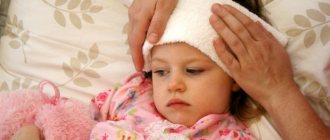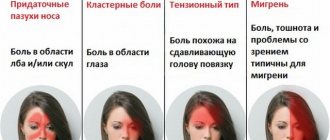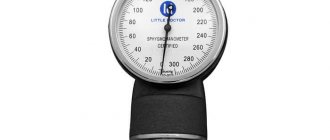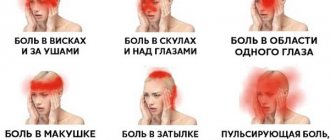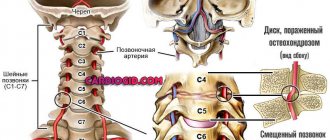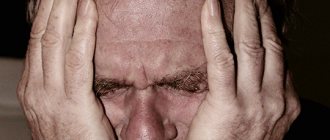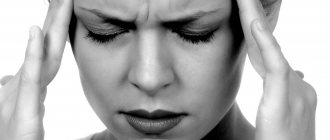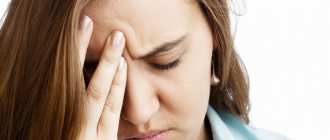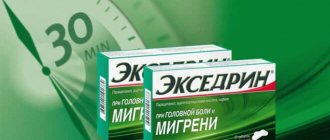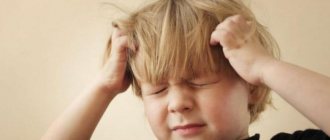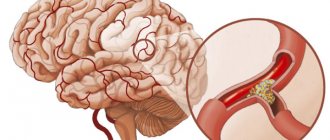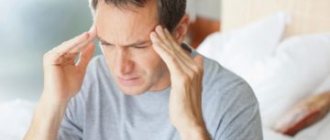Causes of frequent headaches in children
Children's headaches can be caused by various reasons. Let's look at the most typical sources of headaches in children.
At the doctor
Tension headache . This type of pain occurs most often in pediatric practice. The nature of the pain is symptoms of constant compression of varying intensity. Pain is associated with the physical or psycho-emotional activity of the child. As a rule, such pain does not cause serious concerns about the child’s health.
Migraine . The nature of the pain is severe unilateral pain in the form of attacks. Pain may be accompanied by impaired hearing, vision, and balance. Migraine attacks often provoke nausea and vomiting.
Increased intracranial pressure . This medical term is not an independent disease. Increased intracranial pressure accompanies many diseases (brain tumors, meningitis, hydrocephalus). Therefore, headaches associated with this problem can be avoided if the underlying pathology is treated.
A child's eye problem may cause headaches
Visual impairment . Eye strain from prolonged reading, watching TV, or spending long periods of time in front of the computer can cause headaches.
The wrong choice of glasses also causes long-lasting headaches. Some eye diseases (glaucoma) cause severe eye pain and headaches.
IMPORTANT: A comprehensive ophthalmological examination will help identify the cause of your child's headaches associated with visual impairment.
Problems in the musculoskeletal frame . Incorrect posture, physical inactivity, and injuries to the musculoskeletal system often cause headaches. In this case, consultation with an orthopedic specialist is recommended. Additional studies of bone and muscle tissue can help identify the source of the headache.
Sports activities have a positive effect on the baby's health
IMPORTANT: Massage, therapeutic exercises, moderate physical activity have a positive effect on correcting problems associated with the spine and headaches associated with diseases of the corset-muscular frame.
Child mental disorders . Anxiety and depression, neuroses, fear, depressed mood are factors that can provoke headaches. Contacting a psychotherapist will help solve the negative causes and consequences of a child’s mental trauma.
Referred or referred pain . This type of pain is caused by other organs, although the pain is felt in completely different places. Thus, inflammation of the maxillary cavities, ear diseases, sore throat due to colds can cause radiating headaches in a child.
Medicines to treat headaches
Other treatments
There are other ways to treat headaches in younger patients, which, however, should only be recommended by a specialist. Similar methods include:
- diet therapy;
- physiotherapy;
- Exercise therapy and therapeutic exercises;
- treatment with folk remedies;
- acupuncture and manual therapy;
- aromatherapy, etc.
Every parent should remember that a headache in a child can be a symptom of pathological processes developing in his body .
Isolated cases of cephalalgia can be treated at home, while regular attacks of headache require mandatory medical intervention. Drug elimination of headache as a symptom can negatively affect the baby’s health and lead to very serious consequences.
How to treat headaches in children?
You cannot ignore a child’s complaints of headaches. There is no need to panic either. Any pain has a cause and is a signal of a problem in the body.
What to do if a child has a headache?
- If your baby complains of a headache, you should find out the cause of the pain.
- It is recommended to distract and calm the child, if possible put him to bed and talk to him calmly
- Mild sweet tea will help relieve tension and calm your baby.
- You can ventilate the room or, even better, take your child for a walk in the fresh air, if weather conditions permit.
- Give your child the opportunity to sleep and rest
- For persistent moderate pain, the baby may be given Ibuprofen or Paracetamol in a dosage appropriate to the child’s age.
Weak sweet tea will help with headaches
IMPORTANT: If the measures taken do not improve the baby’s condition, and the child continues to feel unwell, you should definitely consult a doctor.
When do you need a doctor's help?
It is recommended to immediately consult a doctor if the following occur with a headache:
- any disorders of consciousness
- speech distortion
- lack of coordination
- visual problems
- appearance of a rash
- nausea and vomiting
- pain after traumatic brain injury
Tablets for children
Briefly
- Causes of cephalgia in children: problems with blood vessels, poor diet, migraines and head injuries, meningitis, neuritis, poisoning, colds.
- Do not use medications not recommended for children or doses intended for adults.
- You cannot do without the help of a doctor in cases of sudden onset of pain, accompanied by nausea, if fainting, convulsions and loss of coordination occur, consciousness is confused, a rash appears, or the symptom was preceded by injury.
- Medicines that are safe to take if you follow the recommendations: Paracetamol, Nurofen, Nise.
- Children are prohibited from taking: Analgin, Aspirin, Citramon.
- As a prophylaxis: Propranolol, Flunarizine, Tenoten.
- Other treatment methods: diet therapy and physiotherapy, exercise therapy, folk remedies, acupuncture, aromatherapy.
What tablets can children take for headaches?
Often parents give “adult” medications to relieve headaches in children. This is a big mistake and misconception.
IMPORTANT: It is not recommended to use medications in pediatric practice intended for the treatment of adults, even if they have indications for treating the same symptoms of the disease.
Paracetamol and Ibuprofen are indicated to relieve pain and fever until a doctor arrives. Other painkillers are prescribed by the attending physician for medical reasons in a dosage according to the child’s age.
Medicine No-shpa
No-spa for headaches for children
No-spa is a drug of synthetic origin containing the active substance - drotaverine.
The medication has an antispasmodic effect, relieves spasms of the smooth muscle muscles of internal organs and blood vessels. Drotaverine relaxes the smooth muscles of the gastrointestinal tract, genitourinary system, bile ducts,
IMPORTANT: No-spa is not a pain reliever. The drug relaxes the walls of smooth muscles, and, as a result, relieves pain if it was associated with muscle spasms.
No-spa enhances the effect of antipyretics
When can you give your child No-shpa?
No-spa is prescribed by a doctor in a dosage according to the age of the baby. In emergency cases, it is possible to use the medicine before the doctor arrives. No-spa relieves pain only in cases associated with spasms of smooth muscles and blood vessels.
Thus, at high temperatures, No-Spa enhances the effect of antipyretic, anti-inflammatory and analgesic medications, as it has a vasodilating effect.
IMPORTANT: At high temperatures, a child can be given 0.5 tablets of No-shpa along with antipyretic drugs Paracetamol or Ibuprofen. The baby’s health returns to normal faster.
Child at a doctor's appointment
Contraindications No-shpa for children
No-spa is not used in the following cases:
- children up to 6 years old
- bronchial asthma
- low blood pressure
- tendency to allergies
- renal and liver failure
Dosage of No-shpa for children
IMPORTANT: Children under one year of age are strictly prohibited from using No-shpa in all dosage forms.
Babies in their first year of life are strictly prohibited from using No-shpa.
Children 6-12 years old : the maximum dose per day is 80 mg (or 2 tablets of 40 mg). It is recommended to take 1 tablet 2 times a day.
Children over 12 years of age : the recommended daily dose is 160 mg, divided into 2-4 doses. Usually the doctor prescribes 1 tablet (40 mg) 2-4 times a day.
IMPORTANT: It should be remembered that No-Spa is an emergency drug for the baby and a temporary measure to make him feel better during the main therapy. The effect of the medicine usually lasts 4-8 hours.
No-shpa in children's practice: video
Analgin tablets
Nonsteroidal anti-inflammatory drugs
To combat headaches associated with migraine and hypotension, alpha-adrenergic receptor antagonists are used. The drugs included in this group eliminate the pathological dilation of blood vessels, leading to blood stagnation. The tone of the walls of capillaries, veins and arteries increases, blood circulation is normalized. The necessary effect is provided by caffeine-based medications, for example, Caffetamine.
In cases where a headache causes significant discomfort, but its cause and nature are unclear, they resort to taking non-steroidal anti-inflammatory drugs. In this case, it is also recommended to first consult a doctor. An impressive list of medications includes products with strong analgesic, antipyretic and blood thinning effects.
Non-steroidal anti-inflammatory drugs are conventionally divided into two groups:
- with a mild effect: Ketorolac, Paracetamol, Panadol, Ketanov, Analgin, Baralgin, Tempalgin, Sedalgin;
- with a pronounced effect: Indomethacin, Diclofenac, Ibuprofen, Ketoprofen, Aspirin, Meloxicam.
The listed products can work as headache relievers for migraines, infectious and inflammatory diseases, neurological lesions, and the threat of vascular thrombosis. When using these medications for headaches as part of complex therapy, it is necessary to take into account their interaction with other medications.
It is impossible to say definitively which headache pills are more effective than others. Even the most powerful drugs based on powerful painkillers will not bring lasting relief if their action is not aimed at eliminating the cause of the problem. Compiling a list of preferred headache pills should be done with your doctor after diagnosis.
When deciding what to drink if you have a headache, you need to remember the following points:
- Try something safe first, such as Ibuprofen or Paracetamol. If there is no result, there is no need to increase the dosage; it is better to immediately choose something more effective;
- It is not recommended to take analgesics for hypotension, hypertension and migraines - these drugs will not give the desired result;
- It is strictly forbidden to combine drugs without a doctor’s permission, this creates a risk of overdose and adverse reactions;
- Regardless of the name of the tablets and what is written in their instructions, you should not take the product for more than 5 days in a row without a prescription from a specialist.
It is important to remember that some pain-relieving products have a sedative effect and affect concentration. Even before taking a pill once, it is recommended to read the instructions, take into account the nuances of therapy and clearly follow the provisions of the proposed treatment regimen.
Analgin
The analgesic effect is achieved by influencing enzymes that trigger the inflammatory process. An affordable and cheap drug relieves pain, but only for a few hours. It is often used as part of complex therapy to enhance results. The maximum dosage is 1 tablet 1-3 times a day for no longer than 3 days. It is forbidden to drink on an empty stomach.
Aspirin
The medicine is effective for migraines, cerebrovascular accidents, pain due to inflammatory processes, and alcohol dependence syndrome. Take 1 tablet after meals up to 3 times a day. The maximum duration of the course is 2 weeks. Today, effervescent tablets are especially popular. The active substance in their composition is absorbed more quickly by the body, so the effect appears earlier than when taking tablets.
Citramon
Taking the product is indicated for mild pain of a compressive nature against the background of an inflammatory process and an increase in temperature. The therapeutic effect is manifested by improving blood circulation in the problem area. Doctors do not recommend taking Citramon for headaches for longer than 3 days. It is better to coordinate the number of appointments with your doctor. It is forbidden to take more than 8 tablets of medication per day.
Paracetamol
Substances in the tablets slow down the synthesis of cells that are responsible for the appearance of pain. The product is well absorbed by the body and helps with headaches of various etiologies and severity. The effect of the medicine appears 15-20 minutes after administration. The medication is used once or up to 4-5 times a day. The duration of therapy should not exceed 5 days.
Diclofenac
The components in the product slow down the formation of substances that cause pain, fever and inflammation. An improvement in the patient's condition is noted 5-10 minutes after taking the medicine. It is not recommended to take more than 3 tablets of the product per day, otherwise adverse reactions will occur.
Tempalgin
A combined medication that relieves pain and has a sedative effect. For persistent pain, take 1 tablet up to 3 times a day. If there is no result, the single dose may be increased by 2 times. The daily volume of the product should not exceed 6 tablets. The maximum duration of therapy is 5 days.
Pentalgin
The drug combines antispasmodic, anti-inflammatory and antipyretic effects. It directly affects the nervous system. This slows down the production of hormones that cause pain. The presence of caffeine in the tablets has a stimulating effect, and the effect of analgesics on the body is enhanced. The desired effect is often achieved with one dose of the medication.
Ibuprofen
A quick-acting drug that can be taken for migraines or headaches of unknown etiology. The first therapeutic effect appears 10 minutes after consuming the product. The effect of the product reaches its peak after 2 hours. You are allowed to take up to 3-4 tablets per day. The maximum duration of therapy is 5 days.
No-Shpa
Eliminates pain by relieving spasm of the muscular walls of blood vessels. The remedy is especially effective in combating symptoms that arise against the background of psychological or neurological problems, stress, and strained neck muscles. Relief occurs 10 minutes after taking the medicine. You are allowed to take 1-2 tablets at a time, the maximum daily dose is 8 tablets. It is prohibited to use No-Shpu for longer than 1-2 days without a doctor’s permission!
Papaverine for headaches
Relieves discomfort by eliminating spasm and dilating blood vessels. The additional sedative effect helps you relax and fall asleep. The medication is taken 2-4 times a day, 1-2 tablets.
Buscopan for headaches
An effective antispasmodic that can relieve severe pain. The advantage of the drug is its ability to work locally, only on the problem area. The medication can be taken as part of complex therapy or for urgent pain relief. It is allowed even in childhood. Dosage: 1-3 doses of 1-2 tablets for adults, 1 tablet up to 2 times for children.
Drotaverine
An antispasmodic that causes tense tissues to actively absorb oxygen. This leads to the filling of cells with calcium ions, relaxation of fibers and pain relief. The drug is approved for use in childhood. Single and daily dosages are selected only by a doctor. For an adult, the maximum daily dose should not exceed 240 mg of the active substance, for a child over 6 years old - no more than 200 mg, for children under 6 years old - 120 mg.
Nurofen plus
A combined remedy that acts as an analgesic, relieves fever and inflammation. A strong analgesic effect is achieved due to the additional presence of codeine. The medicine even helps with migraine attacks. It alleviates the general condition, eliminates nausea, increased sensitivity to sounds and light. It is recommended to take 1 tablet up to 4 times a day with a break of at least 4 hours. The maximum duration of therapy is 3 days.
Galidor
Relieves spasms of cerebral vessels. This is a potent drug that often causes side effects. The dosage and schedule for taking the product are determined by the doctor, based on the diagnosis and characteristics of the situation.
Spazgan for headaches
A complex product that relieves spasm of vascular walls, dulls pain and inhibits the inflammatory process. The effect appears quickly and lasts for 4-8 hours. The medicine is approved for use for headaches of any etiology, but it is better to first obtain a doctor’s permission. This is a one-time use product; it is forbidden to drink more than 4-6 tablets per day. If necessary, therapy can be extended to 3 days.
Drugs safe for baby's health
With so many medications, how can you figure out what to give your child for a headache? There are relatively safe drugs that can be used by children of all ages. The main thing is to maintain the correct dosage and interval between doses of the medication. The degree of safety for children and the intensity of the drug’s effect depend on compliance with these conditions.
Preparations based on paracetamol. They can relieve a child’s headache, normalize body temperature, and reduce fever. The release form is suspensions, suppositories, tablets and capsules, which makes it possible to use Paracetamol as a pain reliever for babies from birth.
The drug "Ibuprofen". It, like the previous one, is the safest for the toddler’s body. As a rule, Ibuprofen itself and drugs containing it can be given to children starting at the age of 6 months.
"Nimesulide". Doctors recommend using this drug only when the previous two have not relieved the pain. When using the medicine for the first time, it is better to give the child half the indicated dose.
These are the main drugs that can alleviate the baby’s condition. But in no case should a mother forget that self-medication can only do harm. The best way out of the situation is to see a doctor.
Headache in children. How to treat if the pain is frequent and migraines are serious?
It is best, as mentioned above, to treat small children under the supervision of a specialist. If your child has frequent headaches or migraines, medications that may help are as follows.
- Paracetamol (suspension or suppositories). It was already mentioned a little higher. It remains to add one more thing. It should be used at the rate of 10 mg per 15 kg of child’s body weight. Yes, this is one of the safest drugs, but its side effect may be liver dysfunction.
- "Acetylsalicylic acid". It will help if the pain is not very severe. But it should not be given to children under two years of age.
- Ibuprofen and Naproxen will come in handy if a mother is trying to figure out what to give her child for a severe headache.
- "Ergatamine." It is not prescribed to children under 11 years of age. There are contraindications, you need to read the instructions.
- “Sedalgin” (under 12 years of age cannot be taken) and other drugs in which the active ingredient is phenacetin.
If your baby has frequent migraines, then...
- visual impairment;
- incorrect posture;
- colds;
- child's mental disorder.
So what is better to give to a child?
- "Dihydroergotamine" in tablets or drops (minus side effects - vomiting and possible allergic reaction).
- Beta blockers. But they are contraindicated for those children who have diseases of the cardiovascular system.
How does your baby react to food?
List of approved drugs for children
Which brand of headache remedies should you choose?
Analgin for children with headaches
Analgin is a drug known for its pain-relieving effect to almost everyone since the time of our grandparents.
Contains the active substance - metamizole sodium. It is used for severe manifestations of pain of various etiologies: migraines, toothaches, renal colic, headaches, painful sensations during menstruation, to relieve pain after surgical operations.
IMPORTANT: Currently, many countries have excluded metamizole sodium (analgin) from medical practice due to the risk of a severe complication of agranulocytosis.
Analgin is available in the form of tablets, rectal suppositories, and injection solutions. Metamizole sodium is included in many complex medications.
Analgin is used in pediatric practice in exceptional cases
In pediatric practice, drugs containing metamizole sodium are used in extreme cases due to the strong toxic effect on the blood composition. Many foreign countries have restricted the use of the drug in children: metamizole sodium is not prescribed to children under 14 years of age. In the Russian Federation, age restrictions reach 6 years.
Description and properties of the drug
Paracetamol - available in white tablets with different dosages. It is used as an antipyretic, analgesic, and anti-inflammatory agent. The main advantage is that it is not addictive and does not harm pregnant women in small doses.
The medicine itself copes with various types of pain, but does not affect the causes. It has a number of contraindications that are specified in the instructions. Particular attention should be paid to the dosage for children, since there are age restrictions indicated by the manufacturer.
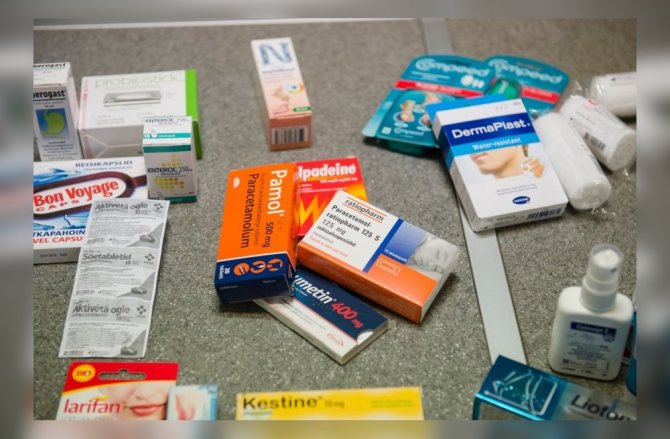
Paracetamol for headaches for children
Paracetamol - the drug has antipyretic, analgesic and moderate anti-inflammatory effects.
Widely used in the form of many dosage forms: tablets, capsules, children's syrups and suspensions, suppositories. Paracetamol is used as a single drug or in combination with other active substances to potentiate the effect.
IMPORTANT: Pediatricians around the world consider Paracetamol the best remedy for reducing fever. In addition, the drug is used as a mild pain reliever for children.
Paracetamol is widely used in children's practice to eliminate pain: headaches, dental, neuralgic, joint and other pains. The drug is also prescribed as an antipyretic agent to reduce fever.
IMPORTANT: Paracetamol is only an emergency remedy for moderate pain and high fever. The drug relieves symptoms only temporarily and involves treating the underlying disease.
Dosage forms of Paracetamol
Dosage forms and dosages
Paracetamol tablets
Paracetamol tablets are available in dosages: 0.2 g, 325 mg, 0.5 g. Dosage form Paracetamol tablets are used for children over 3 years of age.
Children from 3 to 6 years : the daily dose is calculated based on 60 mg per 1 kg of child weight. The dose is divided into 3-4 doses per day.
Children from 6 to 12 years : a single dose of 250-500 mg 3-4 times a day, no more than 4 hours after taking the previous dose of the medicine.
Children over 12 years of age with a body weight above 60 kg: a single dose of 500 mg up to 4 times a day.
The tablets are taken after meals.
Paracetamol suppositories
Paracetamol in rectal suppositories
Paracetamol in the form of rectal suppositories is available in different dosages designed for different age categories of children: 0.08 g, 0.17 g, 0.33 g.
Children from 1 month to 3 years : a single dose is 15 mg of the drug per 1 kg of weight.
Children from 3 to 6 years : 60 mg of paracetamol per 1 kg of child’s weight.
Children from 6 to 12 years : the maximum daily dose is 2 g of the drug, divided into 4 doses.
Suppositories are administered rectally at temperatures above 38 degrees 3-4 times a day with an interval of 4 hours. The medicine is best administered at night. A very convenient dosage form for young children. Pain and temperature decrease within an hour, the effect of the medicine lasts 3-4 hours.
Paracetamol syrup
Paracetamol in the form of syrup and suspension
A specially developed dosage form for young children. It has a pleasant fruity taste and aroma. The syrup contains a small amount of sugar and other harmless ingredients. There is no sugar in the suspension, which makes it possible to use the medicine in case of an allergic predisposition of the child.
The drug can be used from the first months of the baby’s life. A convenient measuring spoon allows you to dose the medicine correctly. Syrup and suspension are available in 50 ml or 100 ml dosages of 120 mg 5 ml.
Children from 3 to 12 months : 2.5-5 ml (60-120 mg of paracetamol) liquid dosage form 3-4 times a day.
Children from 1 year to 5 years : 5-10 ml (120-240 mg paracetamol).
Children from 5 to 12 years : 10-20 ml of suspension (240-480 mg of paracetamol).
Paracetamol analogs
The drug is also available under other trade names:
- Panadol
- Tylenol
- Ifimol
- Calpol
- Aldolor
- Daleron
- Perfalgan
- Tsefekon D
- Efferalgan
- Flutabs
Combination products with Paracetamol
Combination drugs including Paracetamol
- Stopgripan
- Grippoflu
- Maxicold
- Antiflu kids
- Paravit for children
- Pharmacitron
- Fervex
- Coldrex
- Tempalgin
- Cold flu
Aspirin or paracetamol? Doctor Komarovsky advises, video
Spazgan tablets
Release form and composition
This medication is available in different forms:
- Pills;
- Soluble powders;
- Syrup;
- Suspensions;
- Suppositories for rectal administration.
The volume is always different, it is necessary to check in pharmacies; medicines are dispensed without a doctor’s prescription.
The description of the composition of the medicine indicates gelatin, potato starch, povidone and lactose. The drug is very quickly absorbed by the body, due to this it begins to quickly affect the body. As a painkiller, the drug begins to act within half an hour after administration.
Spazgan for children from headaches
Spazgan is a foreign-made combination drug. Contains three active ingredients that have a healing effect:
- metamizole sodium 500 mg (weak anti-inflammatory, antipyretic and analgesic effect)
- pitofenol 5 mg (antispasmodic effect on smooth muscles)
- fenpiverinium bromide 0.1 mg (m-anticholinergic relaxing effect on smooth muscles)
The combination of three active components allows you to potentiate each other's action and eliminate pain and spasms. The medicine is used for colic of various etiologies, headaches, pain syndromes in the joints, neuralgic and other moderate pain.
IMPORTANT: In pediatric practice, Spazgan is used only on medical advice according to medical indications.
Children's dosages are calculated taking into account the age of the child. The instructions for the drug contain recommended doses for children.
Children 6-8 years old : single dose - 0.5 tablets
Children: 9-12 years : 34 tablets at a time
Children: 13-15 years old : 1 tablet
The drug is taken after meals 2-3 times a day.
Citramon P
Prophylactic uses
The use of any medications for preventive purposes must be approved by a pediatrician!
To prevent cephalalgia, children are recommended to take the following medications:
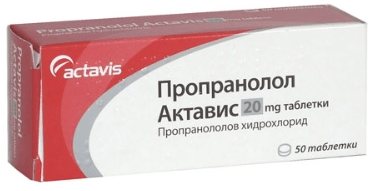
The dosage is calculated individually according to the following scheme: 1 mg/1 kg of baby’s weight. The frequency of administration is 2 times a day. Flunarizine , which prevents the development of migraines and has a positive effect on blood circulation in the brain. The dosage for children whose body weight is above 40 kg is 5 mg once a day.
Tenoten , which is a nootropic drug and has a mild sedative and anti-anxiety effect. Recommended for children over 3 years of age at a dosage of 1 tablet every 8-24 hours.
Citramon for headaches for children
Perhaps there is no medicine more popular than Citramon for headaches. How many times have these pills helped and relieved pain in adults! Is it possible to give Citramon to children for headaches?
Citramon is a complex complex of active ingredients aimed at eliminating moderate pain.
Composition of Citramon tablets:
- acetylsalicylic acid (aspirin) 0.24 g (analgesic, anti-inflammatory, antipyretic and antiaggregation effect)
- paracetamol 0.18 (antipyretic, analgesic and mild anti-inflammatory effect)
- caffeine 0.03 (psychostimulant, cardiotonic and analeptic effects)
- excipients: cocoa powder and citric acid
Citramon tablets are used in pediatrics from the age of 15
Citramon is used to relieve fever and mild pain: headaches, dental, neuralgic, joint pain. The tablets help relieve fever, headaches and muscle pain during colds. Tablets are taken 2-3 times a day after meals.
IMPORTANT: Citramon is not prescribed to children under 15 years of age. The medicine contains acetylsalicylic acid. The use of aspirin for hyperthermia during a viral pathology can cause a dangerous complication - Reye's syndrome.
Medicines to treat headaches
Analogs
Pharmacies today offer a wide range of analogues of the drug. If an illness occurs, it is better to use a children's drug for treatment. There are also analogues that do not contain paracetamol; they are recommended for those who have contraindications to the drug in its pure form. For example, analgesics and, at the same time, anti-inflammatory drugs containing paracetamol Ibuklin, Rinza, Koldek, Taraflu, Efferalgan, Lupocet, Lecadol and many others. Analogs are produced by manufacturers in different countries: France, Bangladesh, Russia, and Great Britain.
The effectiveness of the medicine for headaches has been proven, but before self-medication, you should consult a doctor.
A moment from a headache for a child
Mig - tablets containing the active ingredient ibuprofen. The drug helps relieve inflammation, eliminates moderate pain and effectively reduces body temperature. The medicine is used in dosages of 200 and 400 mg.
The tablets eliminate pain of various etiologies: headaches, dental, muscle, neuralgic. Mig lowers the temperature during infectious processes.
Doses of Mig tablets for children
Children 6-9 years old (weighing 20-29 kg): 200 mg per dose.
Children 9-12 years old (weighing 30-39 kg): 200 mg per dose.
Children over 12 years of age (weighing more than 40 kg): single dose 200-400 mg.
The medicine is taken during or after meals 3 times a day 6 hours after the previous dose. It is not recommended to use the tablets for more than 4 days without a doctor's prescription.
Healthy children are the concern of parents
Tips for parents
Taking medications is a simple and not always effective method of eliminating the disease. Using pills, you can temporarily alleviate the child’s condition. Regular pain in the head area may indicate serious problems in the child’s health. Let's give some tips on how to prevent childhood headaches.
- Regular age-related medical examinations will help prevent many childhood diseases
- A normal psycho-emotional climate in family relationships has a positive effect on the development of the child’s nervous system
- Correct daily routine, nutrition, sleep, proper rest and more?
